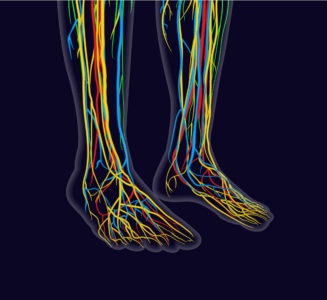 Your sural nerve runs down the back of your leg, behind the outside edge of your ankle and down the outside of your foot. It provides sensation to those areas and to your two outside toes, and problems can occur if the nerve is irritated or damaged. Below, we take a closer look at why your sural nerve can become damaged, and how it is treated.
Your sural nerve runs down the back of your leg, behind the outside edge of your ankle and down the outside of your foot. It provides sensation to those areas and to your two outside toes, and problems can occur if the nerve is irritated or damaged. Below, we take a closer look at why your sural nerve can become damaged, and how it is treated.
Causes and Symptoms of Sural Neuritis
Irritation or damage to the sural nerve is known as sural neuritis, and it’s more common than you think. Damage to your sural nerve can come from a number of different sources, but the most common way a person injuries their sural nerve is during an ankle sprain. The nerve can also be irritated due to inflammation or swelling, or as a result of a surgery gone wrong, although it is rare that a surgeon will damage the nerve. More often, surgical repairs in the area result in scar tissue formation that irritates the nerve.
Symptoms of sural nerve irritation include:
- Pain on the outside of the foot
- A burning sensation
- Symptoms that are aggravated by direct pressure
- Hypersensitivity
- Localized tenderness
Diagnosing and Treating Sural Nerve Problems
Treating sural nerve issues begins with an accurate diagnosis, and this is best achieved through a physical exam with an orthopedic specialist. Your doctor will ask about your symptoms and take a closer look at your foot. They may also conduct some physical manipulation tests to see if certain movements cause the onset of symptoms. One such test is known as the Tinel test, which involves percussion at the nerve site to see if pain or electrical-like sensations are felt. Doctors will also look for swelling or tenderness in the area. If they suspect that sural nerve damage has occurred, they will likely order some imaging tests.
Since the issue is with a nerve, an x-ray isn’t going to be very helpful in diagnosing the issue. The nerve is so small that MRIs also aren’t usually helpful, but advances in ultrasound technology have led to cheaper and more effective imaging tests. These types of imaging tests can also rule out the possibility of other problems like arthritis or fractures.
The goal of sural nerve treatment is to free the nerve from the underlying issue that is causing the irritation. In most cases, sural nerve problems can be managed with non-surgical treatment techniques. Some common non-operative treatment options include:
- Desensitization – This involves direct massage to the area, which may help to break up scar tissue and desensitize the area over time.
- Anti-inflammatory medications.
- Corticosteroid injections to break up scar tissue and calm localized irritation.
- Changes in footwear to avoid direct pressure on the area.
On the off chance that conservative care techniques did not correct the issue, minimally invasive surgery may be your best option. Surgery has two main goals – to free the nerve from the compression, and to prevent the nerve from again becoming compressed by the structure. This is usually achieved by freeing the nerve from the scar tissue, then wrapping it in collagen. If damage is too extreme, part of the nerve may be removed. This will only result in some numbness, but no loss of motor function.